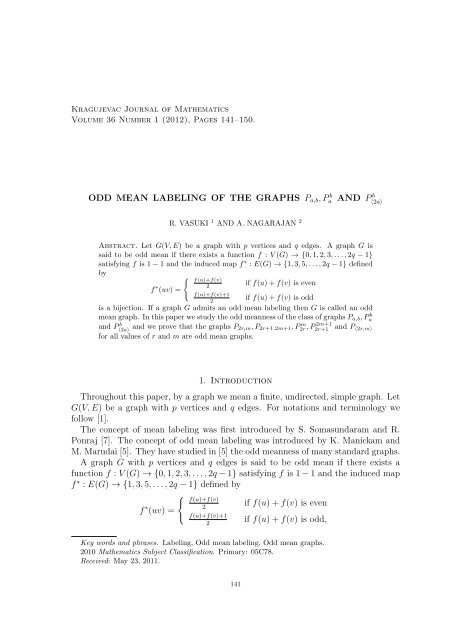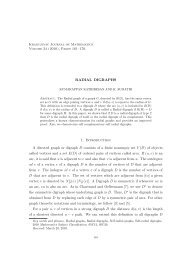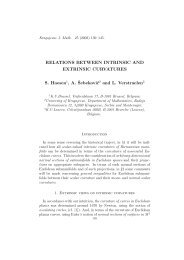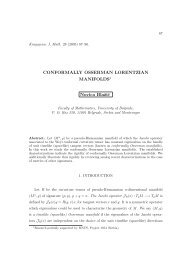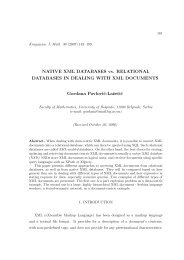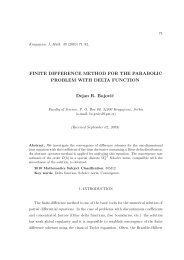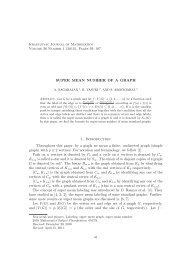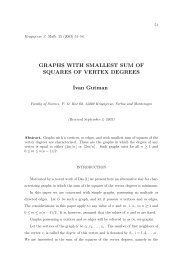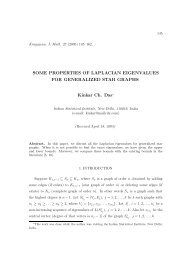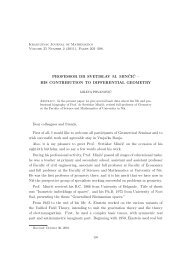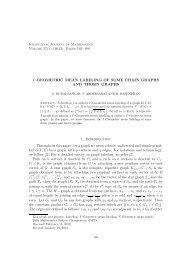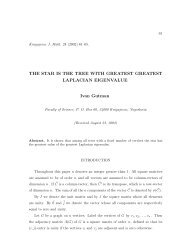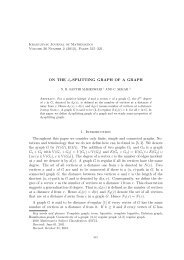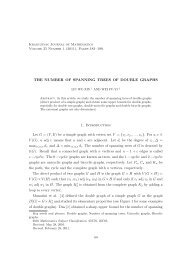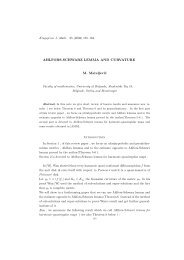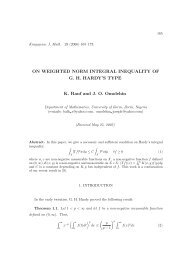Odd mean labeling of the graphs $P_{a,b}
Odd mean labeling of the graphs $P_{a,b}
Odd mean labeling of the graphs $P_{a,b}
You also want an ePaper? Increase the reach of your titles
YUMPU automatically turns print PDFs into web optimized ePapers that Google loves.
Kragujevac Journal <strong>of</strong> Ma<strong>the</strong>matics<br />
Volume 36 Number 1 (2012), Pages 141–150.<br />
ODD MEAN LABELING OF THE GRAPHS P a,b , P b a<br />
AND P b 〈2a〉<br />
R. VASUKI 1 AND A. NAGARAJAN 2<br />
Abstract. Let G(V, E) be a graph with p vertices and q edges. A graph G is<br />
said to be odd <strong>mean</strong> if <strong>the</strong>re exists a function f : V (G) → {0, 1, 2, 3, . . . , 2q − 1}<br />
satisfying f is 1 − 1 and <strong>the</strong> induced map f ∗ : E(G) → {1, 3, 5, . . . , 2q − 1} defined<br />
by<br />
{ f(u)+f(v)<br />
f ∗ 2<br />
if f(u) + f(v) is even<br />
(uv) =<br />
f(u)+f(v)+1<br />
2<br />
if f(u) + f(v) is odd<br />
is a bijection. If a graph G admits an odd <strong>mean</strong> <strong>labeling</strong> <strong>the</strong>n G is called an odd<br />
<strong>mean</strong> graph. In this paper we study <strong>the</strong> odd <strong>mean</strong>ness <strong>of</strong> <strong>the</strong> class <strong>of</strong> <strong>graphs</strong> P a,b , Pa<br />
b<br />
and P〈2a〉 b and we prove that <strong>the</strong> <strong>graphs</strong> P 2r,m, P 2r+1,2m+1 , P2r m , P2r+1 2m+1 and P 〈2r,m〉<br />
for all values <strong>of</strong> r and m are odd <strong>mean</strong> <strong>graphs</strong>.<br />
1. Introduction<br />
Throughout this paper, by a graph we <strong>mean</strong> a finite, undirected, simple graph. Let<br />
G(V, E) be a graph with p vertices and q edges. For notations and terminology we<br />
follow [1].<br />
The concept <strong>of</strong> <strong>mean</strong> <strong>labeling</strong> was first introduced by S. Somasundaram and R.<br />
Ponraj [7]. The concept <strong>of</strong> odd <strong>mean</strong> <strong>labeling</strong> was introduced by K. Manickam and<br />
M. Marudai [5]. They have studied in [5] <strong>the</strong> odd <strong>mean</strong>ness <strong>of</strong> many standard <strong>graphs</strong>.<br />
A graph G with p vertices and q edges is said to be odd <strong>mean</strong> if <strong>the</strong>re exists a<br />
function f : V (G) → {0, 1, 2, 3, . . . , 2q − 1} satisfying f is 1 − 1 and <strong>the</strong> induced map<br />
f ∗ : E(G) → {1, 3, 5, . . . , 2q − 1} defined by<br />
{ f(u)+f(v)<br />
if f(u) + f(v) is even<br />
2<br />
f ∗ (uv) =<br />
f(u)+f(v)+1<br />
2<br />
if f(u) + f(v) is odd,<br />
Key words and phrases. Labeling, <strong>Odd</strong> <strong>mean</strong> <strong>labeling</strong>, <strong>Odd</strong> <strong>mean</strong> <strong>graphs</strong>.<br />
2010 Ma<strong>the</strong>matics Subject Classification. Primary: 05C78.<br />
Received: May 23, 2011.<br />
141
142 R. VASUKI AND A. NAGARAJAN<br />
is a bijection. If a graph G has an odd <strong>mean</strong> <strong>labeling</strong>, <strong>the</strong>n we say that G is an odd<br />
<strong>mean</strong> graph.<br />
An odd <strong>mean</strong> <strong>labeling</strong> <strong>of</strong> <strong>the</strong> cube is given in Figure 1.<br />
0<br />
6<br />
2<br />
8<br />
<br />
✱16 18❅ ✱ <br />
❅ <br />
22 23<br />
Figure 1.<br />
In [2], Kathiresan established that <strong>the</strong> graph P r,2m+1 is graceful for all values <strong>of</strong> r<br />
and m and conjectured that P a,b is graceful except when a = 2r + 1 and b = 4s + 2.<br />
In [6] Sekar proved <strong>the</strong> conjecture except in one case where a = 4r + 1(r > 1) with<br />
<strong>the</strong> corresponding b = 4m(m > r). In [3, 4], Ganesan discussed <strong>the</strong> magic <strong>labeling</strong><br />
<strong>of</strong> <strong>the</strong> type (1, 1, 1) and consecutive <strong>labeling</strong> <strong>of</strong> <strong>the</strong> type (1, 1, 1) <strong>of</strong> <strong>the</strong> plane <strong>graphs</strong><br />
P a,b and d-anti magic <strong>labeling</strong> <strong>of</strong> <strong>the</strong> plane <strong>graphs</strong> Pa. b Meanness <strong>of</strong> <strong>the</strong> <strong>graphs</strong> P a,b<br />
and Pa b are discussed in [8]. Motivated by <strong>the</strong>se works, in this paper, we study <strong>the</strong><br />
odd <strong>mean</strong>ness <strong>of</strong> <strong>the</strong> class <strong>of</strong> <strong>graphs</strong> P a,b , Pa b and P〈2a〉 b and we prove that <strong>the</strong> <strong>graphs</strong><br />
P 2r,m , P 2r+1,2m+1 , P2r m , P2r+1 2m+1 and P〈2r〉 m for all values <strong>of</strong> r and m are odd <strong>mean</strong> <strong>graphs</strong>.<br />
2. <strong>Odd</strong> Meanness <strong>of</strong> <strong>the</strong> Graphs P a,b<br />
Let u and v be two fixed vertices. We connect u and v by <strong>mean</strong>s <strong>of</strong> b ≥ 2 internally<br />
disjoint paths <strong>of</strong> length a ≥ 2 each. The resulting graph embedded in a plane is<br />
denoted by P a,b .<br />
Let v0, i v1, i v2, i . . . , va i be <strong>the</strong> vertices <strong>of</strong> <strong>the</strong> i th copy <strong>of</strong> <strong>the</strong> path <strong>of</strong> length a where<br />
i = 1, 2, . . . , b, v0 i = u and va i = v for all i. We observe that <strong>the</strong> graph P a,b has<br />
(a − 1)b + 2 vertices and ab edges.<br />
For example P 4,5 is shown in Figure 2.<br />
Figure 2.<br />
Theorem 2.1. P 2r,m is an odd <strong>mean</strong> graph for all values <strong>of</strong> r and m.
ODD MEAN LABELING OF THE GRAPHS P a,b , P b a AND P b 〈2a〉 143<br />
Pro<strong>of</strong>. Let v i 0, v i 1, v i 2, . . . , v i 2r be <strong>the</strong> vertices <strong>of</strong> <strong>the</strong> i th copy <strong>of</strong> <strong>the</strong> path <strong>of</strong> length 2r<br />
where i = 1, 2, . . . , m, v i 0 = u and v i 2r = v for all i. We observe that <strong>the</strong> number <strong>of</strong><br />
vertices <strong>of</strong> <strong>the</strong> graph P 2r,m has (2r − 1)m + 2 vertices and <strong>the</strong> number <strong>of</strong> edges <strong>of</strong> <strong>the</strong><br />
graph is 2rm.<br />
Case(i) When m is odd.<br />
Let m = 2k + 1 for some k ∈ Z + .<br />
Define f on V (P 2r,2k+1 ) as follows:<br />
f(u) =0,<br />
f(v) =4rm − 1,<br />
f(v2j+1) i =4mj + 4i − 2, i = 1, 2, . . . , m, j = 0, 1, 2, . . . , r − 1<br />
⎧<br />
⎪⎨ (4m + 3) + 4m(j − 1) + 4(i − 1), 1 ≤ i ≤ k<br />
and f(v2j) i = (2m + 1) + 4m(j − 1) + 4(i − (k + 1)), k + 1 ≤ i ≤ 2k + 1,<br />
⎪⎩<br />
j = 1, 2, . . . , r − 1.<br />
It can be verified that <strong>the</strong> label <strong>of</strong> <strong>the</strong> edges <strong>of</strong> <strong>the</strong> graph are 1, 3, 5, . . . , 2q −1. Hence,<br />
P 2r,2k+1 is an odd <strong>mean</strong> graph for all values <strong>of</strong> r and k.<br />
Case(ii) When m is even.<br />
Let m = 2k for some k ∈ Z + .<br />
Define f on V (P 2r,2k ) as follows:<br />
f(u) =0,<br />
f(v) =4rm − 1,<br />
f(v2j+1) i =4mj + 4i − 2, i = 1, 2, . . . , m, j = 0, 1, 2, . . . , r − 1<br />
⎧<br />
⎪⎨ 4m + 4m(j − 1) + 4(i − 1),<br />
1 ≤ i ≤ k<br />
and f(v2j) i = 2m + 3 + 4m(j − 1) + 4(i − (k + 1)), k + 1 ≤ i ≤ 2k,<br />
⎪⎩<br />
j = 1, 2, . . . , r − 1.<br />
It is easy to check that <strong>the</strong> label <strong>of</strong> <strong>the</strong> edges <strong>of</strong> <strong>the</strong> graph are 1, 3, 5, . . . , 2q−1. Hence,<br />
P 2r,2k is an odd <strong>mean</strong> graph. Thus P 2r,m is an odd <strong>mean</strong> graph for all r and m.<br />
For example, odd <strong>mean</strong> <strong>labeling</strong>s <strong>of</strong> <strong>the</strong> <strong>graphs</strong> P 8,5 and P 6,6 are shown in Figure 3.<br />
□<br />
0 <br />
2 23 22 43 42 63 62 <br />
6 27 26 47 46 67 66 <br />
10 11 30 31 50 51 70 <br />
14 15 34 35 54 55 74 <br />
<br />
18 19 38 39 58 59 78<br />
P 8,5<br />
79
144 R. VASUKI AND A. NAGARAJAN<br />
0 <br />
2 24 26 48 50 <br />
6 28 30 52 54<br />
10 32 34 56 58<br />
14 15 38 39 62 <br />
<br />
18 19 42 43 66<br />
<br />
22 23 46 47 70<br />
P 6,6<br />
Figure 3.<br />
Theorem 2.2. P 2r+1,2m+1 is an odd <strong>mean</strong> graph for all values <strong>of</strong> r and m.<br />
Pro<strong>of</strong>. Let v i 0, v i 1, v i 2, . . . , v i 2r+1 be <strong>the</strong> vertices <strong>of</strong> <strong>the</strong> i th copy <strong>of</strong> <strong>the</strong> path <strong>of</strong> length<br />
2r + 1 where i = 1, 2, . . . , 2m + 1, v i 0 = u and v i 2r+1 = v for all i. We observe that <strong>the</strong><br />
number <strong>of</strong> vertices <strong>of</strong> <strong>the</strong> graph P 2r+1,2m+1 is 2r(2m + 1) + 2 and <strong>the</strong> number <strong>of</strong> edges<br />
<strong>of</strong> <strong>the</strong> graph is (2r + 1)(2m + 1).<br />
Define f on V (P 2r+1,2m+1 ) as follows:<br />
f(u) =0,<br />
f(v) =2(2r + 1)(2m + 1) − 1,<br />
f(v2j+1) i =(4(2m + 1) + 3)j + 4i − 3, i = 1, 2, . . . , 2m + 1, j = 0, 1, 2, . . . , (r − 1)<br />
⎧<br />
(4(2m + 1) + 4) + (4(2m + 1) + 3)(j − 1)<br />
⎪⎨ +4(i − 1),<br />
1 ≤ i ≤ m<br />
and f(v2j) i = (2m + 2) + (4(2m + 1) + 3)(j − 1)<br />
+4(i − (m + 1)), m + 1 ≤ i ≤ 2m + 1,<br />
⎪⎩<br />
j = 1, 2, . . . , r.<br />
It can be verified that <strong>the</strong> label <strong>of</strong> <strong>the</strong> edges <strong>of</strong> <strong>the</strong> graph are 1, 3, 5, . . . , 2q −1. Hence,<br />
P 2r+1,2m+1 is an odd <strong>mean</strong> graph.<br />
For example, an odd <strong>mean</strong> <strong>labeling</strong> <strong>of</strong> <strong>the</strong> graph P 7,7 is shown in Figure 4. □<br />
1 32 29 60 57 88 <br />
5 36 33 64 61 92 <br />
9 40 37 68 65 96 <br />
13 16 41 44 69 72<br />
❍<br />
<br />
<br />
0 ❍<br />
97<br />
❍<br />
❍ <br />
❍<br />
❍ 17 20 45 48 73 76<br />
❍<br />
❍ <br />
21 24 49 52 77 80<br />
<br />
25 28 53 56 81 84<br />
P 7,7<br />
Figure 4.<br />
<br />
71
ODD MEAN LABELING OF THE GRAPHS P a,b , P b a AND P b 〈2a〉 145<br />
3. <strong>Odd</strong> <strong>mean</strong>ness <strong>of</strong> <strong>the</strong> Graphs P b a<br />
Let a and b be integers such that a ≥ 2 and b ≥ 2. Let y 1 , y 2 , . . . , y a be <strong>the</strong> fixed<br />
vertices. We connect <strong>the</strong> vertices y i and y i+1 by <strong>mean</strong>s <strong>of</strong> b internally disjoint paths<br />
P j<br />
i <strong>of</strong> length i + 1 each, 1 ≤ i ≤ a − 1, 1 ≤ j ≤ b. Let y i , x i,j,1 , x i,j,2 , . . . , x i,j,i , y i+1 be<br />
<strong>the</strong> vertices <strong>of</strong> <strong>the</strong> path P j<br />
i , where 1 ≤ i ≤ a − 1 and 1 ≤ j ≤ b. The resulting graph<br />
embedded in a plane is denoted by Pa, b where<br />
V (P b a) ={y i : 1 ≤ i ≤ a} ∪<br />
and<br />
a−1<br />
⋃<br />
E(Pa) b =<br />
i=1<br />
a−1<br />
⋃<br />
i=1 j=1<br />
{y i , x i,j,1 : 1 ≤ j ≤ b} ∪<br />
a−1<br />
⋃<br />
{x i,j,i y i+1 : 1 ≤ j ≤ b}<br />
i=1<br />
b⋃<br />
{x i,j,k : 1 ≤ k ≤ i}<br />
a−1<br />
⋃<br />
i=2 j=1<br />
b⋃<br />
{x i,j,k x i,j,k+1 : 1 ≤ k ≤ i − 1}<br />
we observe that <strong>the</strong> number <strong>of</strong> vertices <strong>of</strong> <strong>the</strong> graph Pa b is ab(a−1) + a and <strong>the</strong> number<br />
2<br />
<strong>of</strong> edges is b(a−1)(a+2) .<br />
2<br />
For example, <strong>the</strong> plane graph P4 3 is shown in Figure 5.<br />
Figure 5.<br />
Theorem 3.1. P 2m+1<br />
r is an odd <strong>mean</strong> graph for all values <strong>of</strong> r and m.<br />
Pro<strong>of</strong>. Let y 1 , y 2 , . . . , y r be <strong>the</strong> fixed vertices. We connect <strong>the</strong> vertices y i and y i+1 by<br />
<strong>mean</strong>s <strong>of</strong> 2m + 1 internally disjoint paths p j i <strong>of</strong> length i + 1 each, 1 ≤ i ≤ r − 1, 1 ≤<br />
j ≤ 2m + 1. Let y i , x i,j,1 , x i,j,2 , . . . , x i,j,i , y i+1 be <strong>the</strong> vertices <strong>of</strong> <strong>the</strong> path P j<br />
i , where<br />
1 ≤ i ≤ r − 1 and 1 ≤ j ≤ 2m + 1. We observe that <strong>the</strong> number <strong>of</strong> vertices <strong>of</strong> <strong>the</strong><br />
graph Pr<br />
2m+1 is (2m+1)r(r−1) + r and <strong>the</strong> number <strong>of</strong> edges is (2m+1)(r−1)(r+2)<br />
2 2<br />
Define f on V (Pr<br />
2m+1 ) as follows:<br />
f(y 1 ) = 0,<br />
f(y i ) = f(y i−1 ) + (2m + 1)2i, 2 ≤ i ≤ r − 1,<br />
f(y r ) = (2m + 1)(r − 1)(r + 2) − 1,<br />
f(x 1,j,1 ) = 4j − 3, 1 ≤ j ≤ 2m + 1,
146 R. VASUKI AND A. NAGARAJAN<br />
{<br />
f(yi ) + f(x 1,j,1 ) + 1 if i is odd<br />
f(x i,j,1 ) =<br />
f(y i ) + f(x 1,j,1 ) if i is even, 2 ≤ i ≤ r − 1,<br />
⎧<br />
f(y i ) + (4(2m + 1) + 4) + 4(i − 1), 1 ≤ i ≤ m,<br />
f(y i ) + (2(2m + 1) + 2)<br />
+4(i − (m + 1)), m + 1 ≤ i ≤ 2m + 1,<br />
⎪⎨<br />
if i is even, 2 ≤ i ≤ r − 1<br />
f(x i,j,2 ) =<br />
f(y i ) + (4(2m + 1) + 3) + 4(i − 1), 1 ≤ i ≤ m<br />
and<br />
f(x i,j,k ) =<br />
⎪⎩<br />
f(y i ) + (2(2m + 1) + 1)<br />
+4(i − (m + 1)), m + 1 ≤ i ≤ 2m + 1,<br />
if i is odd, 3 ≤ i ≤ r − 1<br />
{<br />
f(xi,j,1 ) + 2(k − 1)(2m + 1), if k is odd, 3 ≤ k < r, k ≤ i ≤ r − 1<br />
f(x i,j,2 ) + 2(k − 2)(2m + 1), if k is even, 4 ≤ k < r, k ≤ i ≤ r − 1.<br />
It can be verified that <strong>the</strong> label <strong>of</strong> <strong>the</strong> edges <strong>of</strong> <strong>the</strong> graph are 1, 3, 5, . . . , 2(2m +1)(r −<br />
1)(r + 2) − 1. Then <strong>the</strong> resultant graph is an odd <strong>mean</strong> graph.<br />
For example, an odd <strong>mean</strong> <strong>labeling</strong> <strong>of</strong> P 5 6 is shown in Figure 6. □<br />
Figure 6.<br />
4. <strong>Odd</strong> <strong>mean</strong>ness <strong>of</strong> <strong>the</strong> graph P b 〈2a〉<br />
Let a and b be integers such that a ≥ 1 and b ≥ 2. Let y 1 , y 2 , . . . , y a+1 be <strong>the</strong><br />
fixed vertices. We connect <strong>the</strong> vertices y i and y i+1 by <strong>mean</strong>s <strong>of</strong> b internally disjoint<br />
path P j<br />
i <strong>of</strong> length 2i each, 1 ≤ i ≤ a, 1 ≤ j ≤ b. Let y i , x i,j,1 , x i,j,2 , . . . , x i,j,2i−1 , y i+1<br />
be <strong>the</strong> vertices <strong>of</strong> <strong>the</strong> path P j<br />
i , where 1 ≤ i ≤ a and 1 ≤ j ≤ b. The resulting graph<br />
embedded in a plane is denoted by P〈2a〉 b where<br />
V (P b 〈2a〉) = {y i : 1 ≤ i ≤ a + 1} ∪<br />
a⋃<br />
i=1 j=1<br />
b⋃<br />
{x i,j,k : 1 ≤ k ≤ 2i − 1}
ODD MEAN LABELING OF THE GRAPHS P a,b , P b a AND P b 〈2a〉 147<br />
and<br />
E(P b 〈2a〉) =<br />
a⋃<br />
{y i x i,j,1 : 1 ≤ j ≤ b} ∪<br />
i=1<br />
a⋃<br />
i=2 j=1<br />
a⋃<br />
{x i,j,2i−1 y i+1 : 1 ≤ j ≤ b}.<br />
i=1<br />
b⋃<br />
{x i,j,k x i,j,k+1 : 1 ≤ k ≤ 2i − 2}<br />
We observe that <strong>the</strong> number <strong>of</strong> vertices <strong>of</strong> <strong>the</strong> graph P〈2a〉 b is a2 b + a + 1 and <strong>the</strong><br />
number <strong>of</strong> edges is a(a + 1)b.<br />
For example, <strong>the</strong> plane graph P〈4〉 4 is shown in Figure 7.<br />
x 2,1,1 x 2,1,2 x<br />
<br />
<br />
2,1,3<br />
x 1,1,1<br />
<br />
<br />
x<br />
<br />
2,2,1 x 2,2,2 x<br />
<br />
<br />
2,2,3<br />
<br />
x 1,2,1<br />
y <br />
y 2 <br />
<br />
1<br />
x 2,3,1 x<br />
x 1,3,1<br />
<br />
2,3,2 x<br />
<br />
2,3,3<br />
<br />
y 3<br />
<br />
<br />
<br />
<br />
<br />
x 1,4,1 x 2,4,1 x 2,4,2 x 2,4,3<br />
P 4 〈4〉<br />
Figure 7.<br />
Theorem 4.1. P m 〈2r〉<br />
is an odd <strong>mean</strong> graph for all values <strong>of</strong> r and m.<br />
Pro<strong>of</strong>. Let y 1 , y 2 , . . . , y r+1 be <strong>the</strong> fixed vertices. We connect <strong>the</strong> vertices y i and y i+1<br />
by <strong>mean</strong>s <strong>of</strong> m internally disjoint paths P j<br />
i <strong>of</strong> length 2i each, 1 ≤ i ≤ r, 1 ≤ j ≤ m.<br />
Let y i , x i,j,1 , x i,j,2 , . . . , x i,j,2i−1 , y i+1 be <strong>the</strong> vertices <strong>of</strong> <strong>the</strong> path P j<br />
i , where 1 ≤ i ≤ r and<br />
1 ≤ j ≤ m. We observe that <strong>the</strong> number <strong>of</strong> vertices <strong>of</strong> <strong>the</strong> graph P m is r 2 m + r + 1<br />
and <strong>the</strong> number <strong>of</strong> edges is r(r + 1)m.<br />
Case(i) When m is odd.<br />
Let m = 2t + 1, t ∈ Z + .<br />
Define f on V (P) m as follows:<br />
f(y 1 ) = 0,<br />
f(y i ) = f(y i−1 ) + 2(2i − 2)m, 2 ≤ i ≤ r,<br />
f(y r+1 ) = 2r(r + 1)m − 1,<br />
f(x 1,j,1 ) = 4j − 2, 1 ≤ j ≤ m,<br />
f(x i,j,1 ) = f(y i ) + f(x 1,j,1 ), 2 ≤ i ≤ r,<br />
{<br />
f(yi ) + (4m + 3) + 4(i − 1), 1 ≤ i ≤ t<br />
f(x i,j,2 ) =<br />
f(y i ) + (2m + 1) + 4(i − (k + 1)),<br />
t + 1 ≤ i ≤ 2t + 1, 2 ≤ i ≤ r
148 R. VASUKI AND A. NAGARAJAN<br />
and<br />
{<br />
f(xi,j,1 ) + 2(k − 1)m if k is odd, 3 ≤ k < 2r, k+1 ≤ i ≤ r<br />
2<br />
f(x i,j,k ) =<br />
f(x i,j,2 ) + 2(k − 2)m if k is even, 4 ≤ k < 2r, k+2 ≤ i ≤ r.<br />
2<br />
It can be verified that, <strong>the</strong> label <strong>of</strong> <strong>the</strong> edges <strong>of</strong> <strong>the</strong> graph are 1, 3, 5, . . . ,<br />
2r(r + 1)m − 1. Hence P 2t+1<br />
〈2r〉<br />
is an odd <strong>mean</strong> graph for all values <strong>of</strong> r and t.<br />
Case(ii) when m is even.<br />
Let m = 2t, t ∈ Z + .<br />
Define f on V (P 2t<br />
2r) as follows:<br />
f(y 1 ) = 0,<br />
f(y i ) = f(y i−1 ) + 2(2i − 2)m,<br />
f(y r+1 ) = 2r(r + 1)m − 1,<br />
f(x 1,j,1 ) = 4j − 2, 1 ≤ j ≤ m,<br />
f(x i,j,1 ) = f(y i ) + f(x 1,j,1 ), 2 ≤ i ≤ r, 1 ≤ j ≤ m,<br />
{<br />
f(yi ) + 4m + 4(i − 1), 1 ≤ i ≤ t<br />
f(x i,j,2 ) =<br />
f(y i ) + (2m + 3) + 4(i − (t + 1)),<br />
t + 1 ≤ i ≤ 2t<br />
and<br />
{<br />
f(xi,j,1 ) + 2(k − 1)m if k is odd, 3 ≤ k < 2r, k+1 ≤ i ≤ r<br />
2<br />
f(x i,j,k ) =<br />
f(x i,j,2 ) + 2(k − 2)m if k is even, 4 ≤ k < 2r, k+2 ≤ i ≤ r.<br />
2<br />
It is easy to check that, <strong>the</strong> label <strong>of</strong> <strong>the</strong> edges <strong>of</strong> <strong>the</strong> graph are 1, 3, 5, . . . ,<br />
2r(r + 1)m − 1. Hence P〈2r〉 2t is an odd <strong>mean</strong> graph for all values <strong>of</strong> r and t. Thus<br />
P〈2r〉 m is an odd <strong>mean</strong> graph for all values <strong>of</strong> r and m.<br />
For example, odd <strong>mean</strong> <strong>labeling</strong>s <strong>of</strong> <strong>the</strong> <strong>graphs</strong> P〈8〉 6 and P 〈8〉 5 are shown in Figure<br />
8. □
ODD MEAN LABELING OF THE GRAPHS P a,b , P b a AND P b 〈2a〉 149<br />
2<br />
22 43 42 <br />
62 83 82 103 102 <br />
122 <br />
143<br />
<br />
142 163 162 182<br />
183 <br />
6 <br />
<br />
<br />
26 47 46<br />
66 87 86 107 106<br />
20<br />
60<br />
120 126 147 146 167 166 187<br />
<br />
186<br />
0 10 <br />
<br />
30<br />
199<br />
31 50<br />
70 71 90 91 110<br />
14 <br />
<br />
130 131 170 190<br />
150 151<br />
<br />
171<br />
34 <br />
35 54 <br />
74 75 94 95 <br />
114 <br />
134 135 154 155 174 175 194 <br />
38 39 58<br />
78 79 98 99 118<br />
138 139 158 159 178 179 198<br />
18<br />
P 5 〈8〉<br />
2 26 48 50 <br />
74 96 98 120 122 <br />
146 <br />
168<br />
<br />
170 192 194<br />
216 218<br />
<br />
✡ ✡✡ 6 <br />
<br />
<br />
30 52 54<br />
78 100 102 124 126<br />
24<br />
72<br />
144 150 172 174 196 198 220<br />
<br />
222<br />
0<br />
10 <br />
<br />
34<br />
239<br />
56 58<br />
82 104 106 128 130<br />
14 <br />
<br />
154 176 202 226<br />
178 200<br />
<br />
224<br />
38 <br />
39 62<br />
86 87 110 111 134<br />
18<br />
<br />
<br />
158 159 182 183 206 207 230<br />
42 <br />
43 66 <br />
90 91 114 115 <br />
138 <br />
162<br />
<br />
163<br />
<br />
186<br />
187 210 <br />
211<br />
234<br />
22<br />
<br />
46 47 70<br />
94 95 118 119 142<br />
166 167 190 191 214 215 238<br />
P<br />
〈8〉<br />
6<br />
Figure 8.
150 R. VASUKI AND A. NAGARAJAN<br />
References<br />
[1] F. Harary, Graph Theory, Addison Wesley, Reading Mass., 1972.<br />
[2] K. M. Kathiresan, Two classes <strong>of</strong> Graceful Graphs, Ars Combin., 55 (2000), 129–132.<br />
[3] K. M. Kathiresan and R. Ganesan, A <strong>labeling</strong> problem on <strong>the</strong> plane <strong>graphs</strong> P a,b , Ars Combin.,<br />
73 (2004), 143–151.<br />
[4] K. M. Kathiresan and R. Ganesan, d-anti magic <strong>labeling</strong> <strong>of</strong> <strong>the</strong> plane <strong>graphs</strong> P b a, J. Combin.<br />
Math. Combin. Comput., 52(2005), 89–96.<br />
[5] K. Manickam and M. Marudai, <strong>Odd</strong> <strong>mean</strong> labeblings <strong>of</strong> <strong>graphs</strong>, Bulletin <strong>of</strong> Pure and Applied<br />
Sciences, 25E (1) (2006), 149–153.<br />
[6] C. Sekar, Gracefulness <strong>of</strong> P a,b , Ars Combin., 72 (2004), 181–190.<br />
[7] S. Somasundaram and R. Ponraj, Mean <strong>labeling</strong>s <strong>of</strong> <strong>graphs</strong>, National Academy Science letter,<br />
26 (2003), 210–213.<br />
[8] R. Vasuki and A. Nagarajan, Meanness <strong>of</strong> <strong>the</strong> <strong>graphs</strong> P a,b and P b a, International Journal <strong>of</strong><br />
Applied Ma<strong>the</strong>matics, 22 (4) (2009), 663–675.<br />
1 Department <strong>of</strong> Ma<strong>the</strong>matics<br />
Dr.Sivanthi Aditanar College <strong>of</strong> Engineering<br />
Tiruchendur - 628 215, Tamil Nadu, India.<br />
E-mail address: vasukisehar@yahoo.co.in<br />
2 Department <strong>of</strong> Ma<strong>the</strong>matics<br />
V.O. Chidambaram College<br />
Thoothukudi - 628 008, Tamil Nadu, India.<br />
E-mail address: nagarajan.voc@gmail.com


